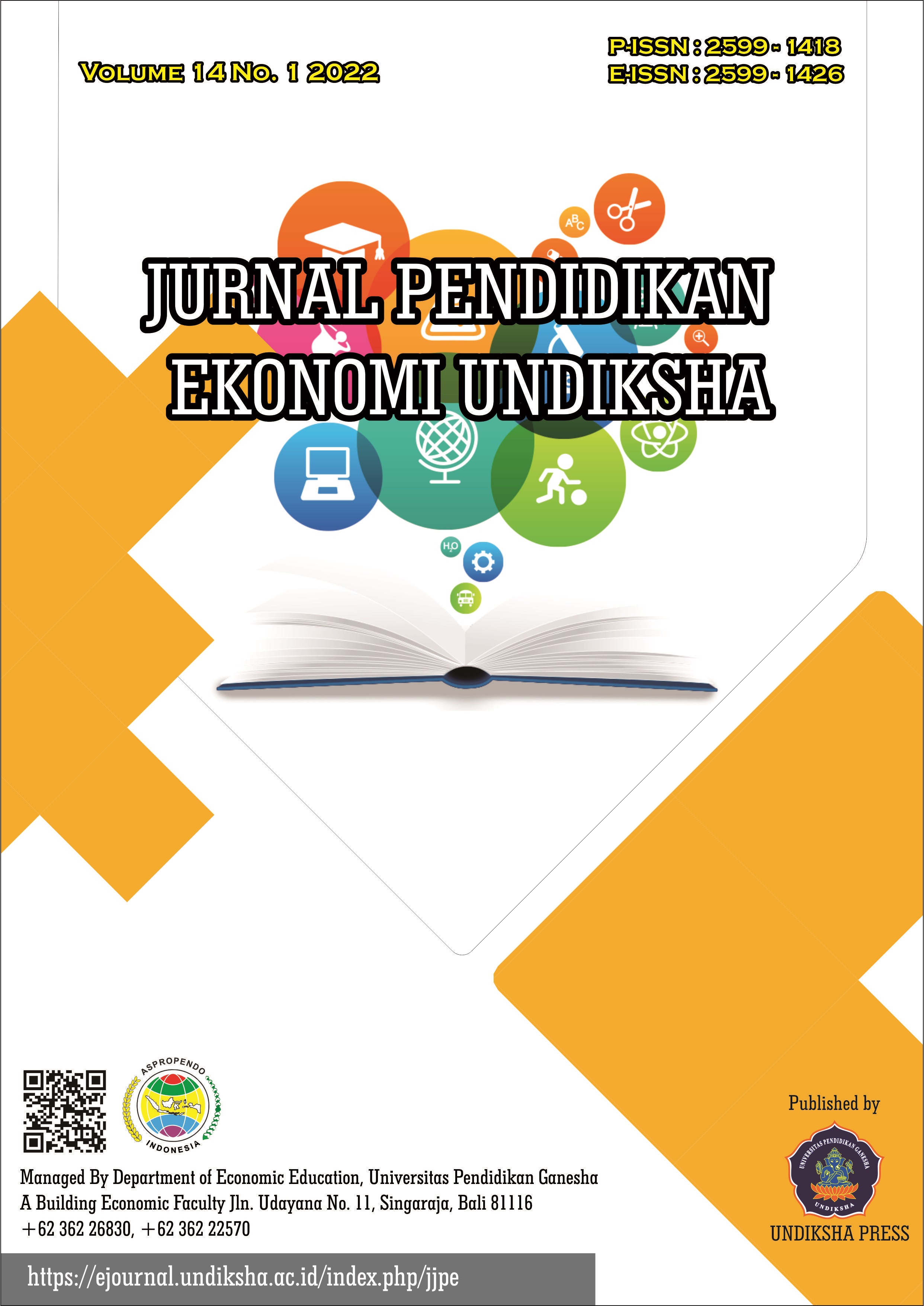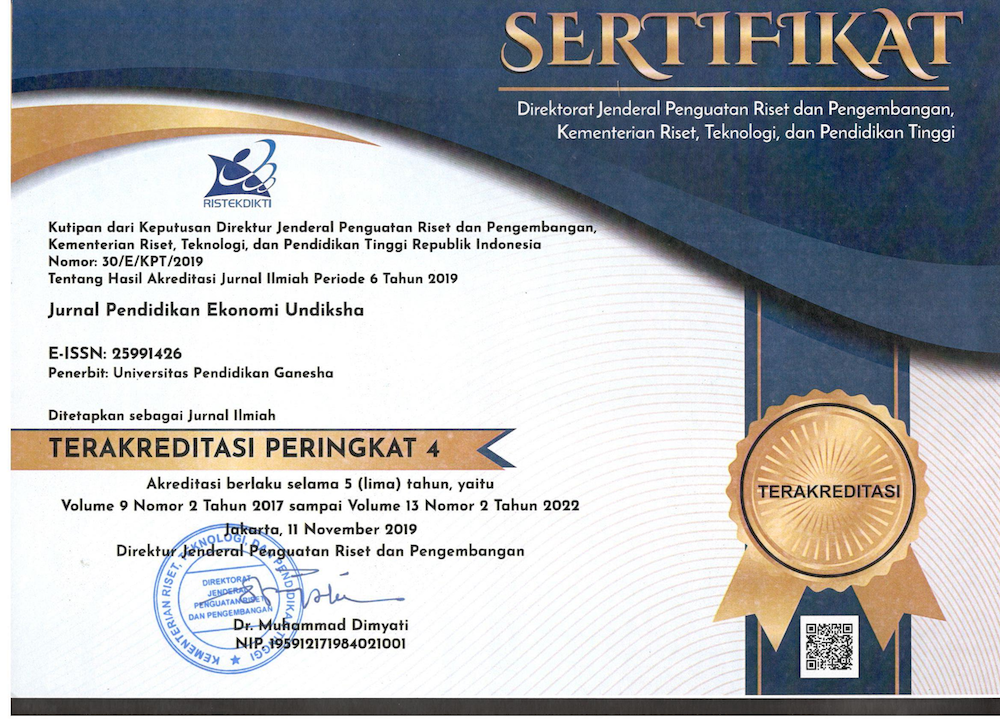Pengembangan Kreativitas Guru: Seminar Online Dalam Meningkatan Pengetahuan Tentang Penyusunan Soal Berbasis HOTs
Keywords:
HOTs, Kreativitas guru, evaluasiAbstract
The life of the 21st century requires creativity to answer the challenges of life's problems. Thus, teachers need cultivate creative students who are very supportive of life which is manifested in the behavior, knowledge, and skills shown through creativity. Teachers are encouraged to cultivate Higher-order Thinking (HOTS) in students in learning activities, not least in learning economics. The HOTS-based learning model must be followed by an HOT-based evaluation as well. However, in reality many teachers still have not applied this model in their teaching activities or still refer to the conventional model. In an effort to improve the quality of teachers, various efforts have been made, one of which is through online seminars. This research is a descriptive study with a percentage to analyze the data obtained. This activity-based research is intended to see the effect of online seminar activities in increasing teacher knowledge to develop HOTS-based questions. This activity was attended by 204 economics teachers as the object of the activity. Data was obtained through questionnaires and documentation using the Google-form platform. The results of data analysis show that online seminar activities are proven to improve teacher understanding in preparing HOTS-based questions.
References
Baten, C. E. (1918). Your Classroom. In Journal of Education (Vol. 88, Issue 18). https://doi.org/10.1177/002205741808801819
Crick, R. D., Mccombs, B., Haddon, A., Broadfoot, P., Deakin, R., Mccombs, B., Haddon, A., Broadfoot, P., Deakin, R., Mccombs, B., & Haddon, A. (2007). Research Papers in Education The ecology of learning : factors contributing to learner ‐ centred classroom cultures The ecology of learning : factors contributing to learner-centred (Vol. 1522). https://doi.org/10.1080/02671520701497555
Ennis, R. H. (1996). Critical Thinking Dispositions: Their Nature and Assessability. Informal Logic, 18(2), 165–182. https://doi.org/10.22329/il.v18i2.2378
Ennis, [Robert H. (2011). Ennis, Robert H. The Nature of Critical Thinking : An Outline of Critical Thinking Dispositions. Emeritus Professor, University of Illinois Last Revised, May, 2011 (pp. 1–8).
Gajda, A., Beghetto, R. A., & Karwowski, M. (2017). Exploring creative learning in the classroom: A multi-method approach. Thinking Skills and Creativity, 24, 250–267. https://doi.org/10.1016/j.tsc.2017.04.002
Garba, S. A., Byabazaire, Y., & Busthami, A. H. (2015). Toward the use of 21st century teaching-learning approaches: The trend of development in Malaysian schools within the context of Asia Pacific. International Journal of Emerging Technologies in Learning, 10(4), 72–79. https://doi.org/10.3991/ijet.v10i4.4717
Gordon, J., & Toole, L. O. (2015). Learning for well-being : creativity and inner diversity. Cambridge Journal of Education, 45(3), 333–349. https://doi.org/10.1080/0305764X.2014.904275
Maher, C. A. (2004). Imaginative teaching, creative learning. Journal of Mathematical Behavior, 23(3), 257. https://doi.org/10.1016/j.jmathb.2004.07.001
Muslihuddin. (2016). Meningkatkan kemampuan guru dalam pembuatan media pembelajaran melalui kegiatan workshop. Jurnal Ilmiah UPT P2M STKIP Siliwangi, 3(2).
Parkes, K. A. a, & Powell, S. R. (2015). Is the edTPA the Right Choice for Evaluating Teacher Readiness? Arts Education Policy Review, 116(2), 103–113. https://doi.org/10.1080/10632913.2014.944964
Prof, I. K., Prof, R. E. F. E., Assoc, E. A., & Kostova, Z. B. (2015). Education in the 21 st Century : Theory and Practice.
Puccio, G. J. (2017). From the Dawn of Humanity to the 21st Century: Creativity as an Enduring Survival Skill. Journal of Creative Behavior, 51(4), 330–334. https://doi.org/10.1002/jocb.203
Raco, J. R. (2010). Metode Penelitian Kualitatif. Grasindo Penerbit PT Gramedia Widiasarana Indonesia, Jakarta
Riordan, T. (2016). 21st Century : Teaching , Learning , and Assessment. 37(1), 52–56.
Serevina, V., Sari, Y. P., & Maynastiti, D. (2019). Developing high order thinking skills (HOTS) assessment instrument for fluid static at senior high school. Journal of Physics: Conference Series, 1185(1). https://doi.org/10.1088/1742-6596/1185/1/012034
Strand, T. (2011). Metaphors of Creativity and Workplace Learning. 3831. https://doi.org/10.1080/00313831.2011.587320
Surjanti, J., Wijayati, D. T., Hadi, H. K., & Muafi. (2018). The Relationship Pattern of Social Support, Work Stress, and Work Satisfaction ; a Context of Non-Certified Primary Education Teacher in Indonesia. 31st IBIMA International Conference, 1–7.
Tan, S. Y., & Halili, S. H. (2015). Effective Teaching of Higher-Order Thinking (HOT) in Education. The Online Journal of Distance Education and E-Learning, 3(2), 41–47.
Tanujaya, B., Mumu, J., & Margono, G. (2017). The Relationship between Higher Order Thinking Skills and Academic Performance of Student in Mathematics Instruction. International Education Studies, 10(11), 78. https://doi.org/10.5539/ies.v10n11p78
Downloads
Published
How to Cite
Issue
Section
License
Copyright (c) 2022 Jurnal Pendidikan Ekonomi Undiksha

This work is licensed under a Creative Commons Attribution-ShareAlike 4.0 International License.





